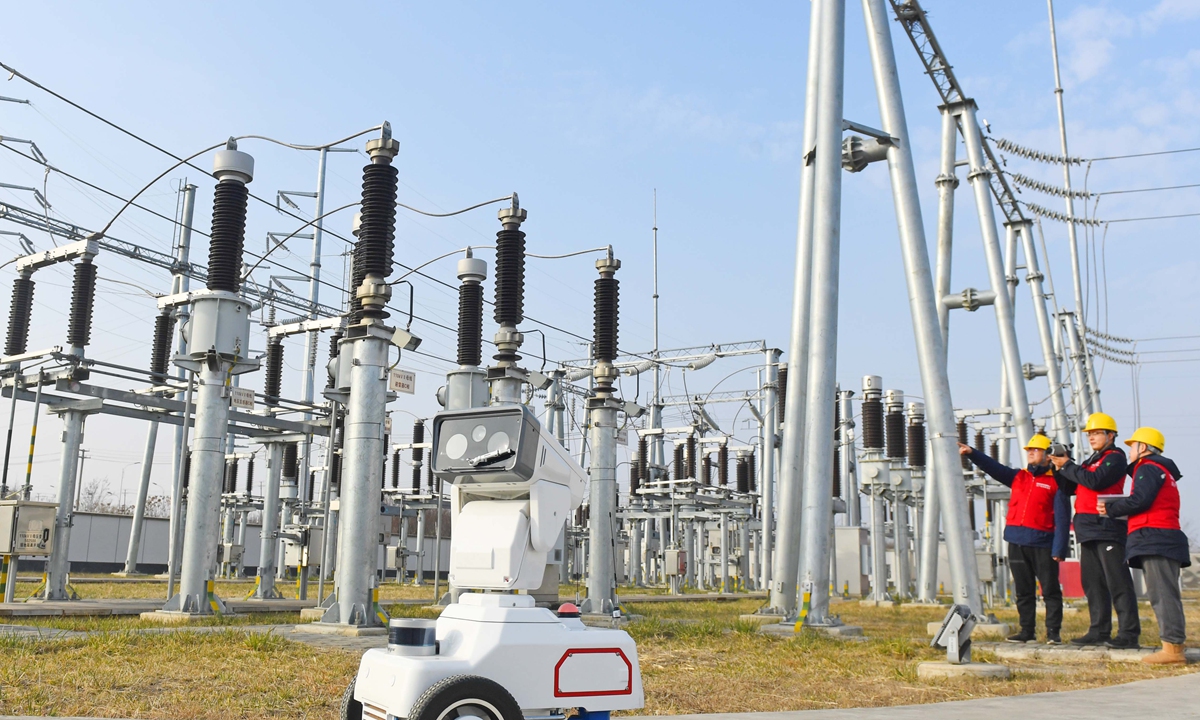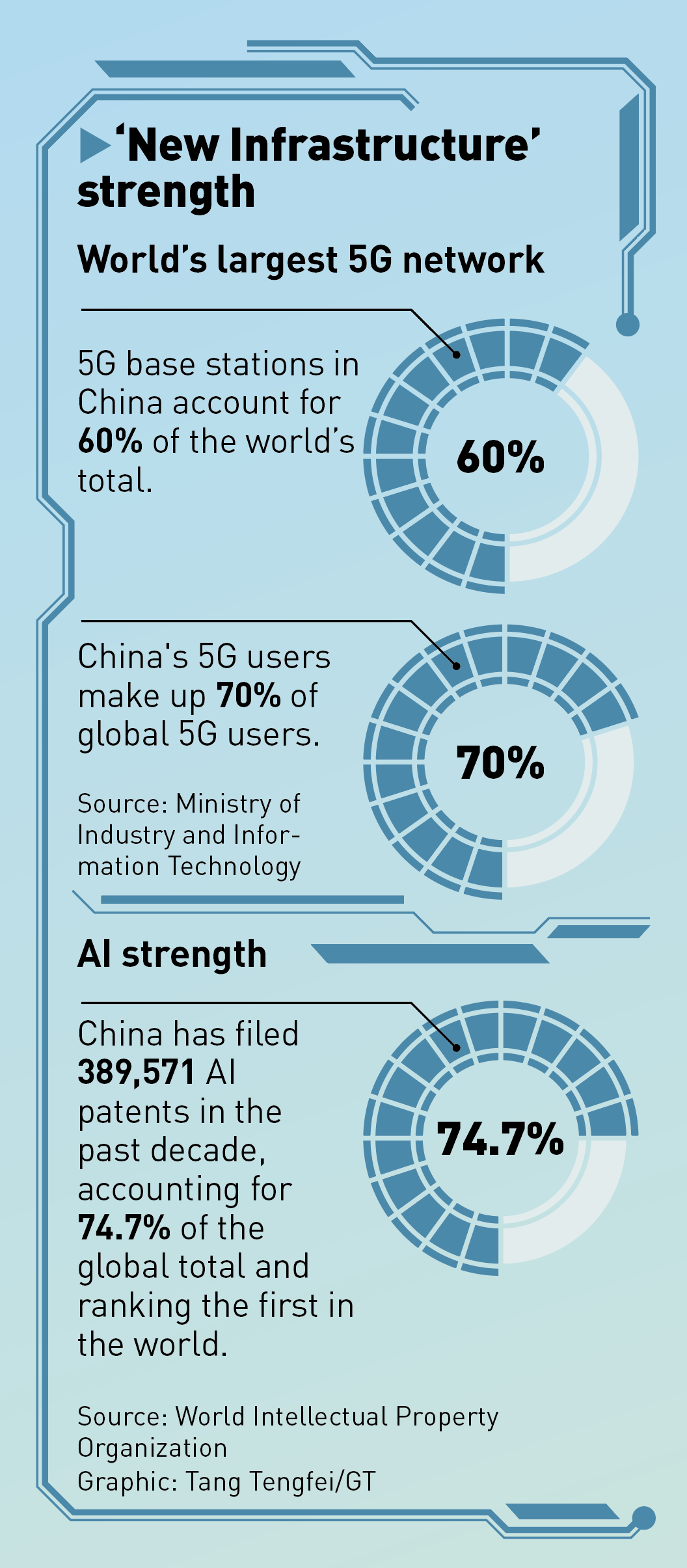LATEST INSIGHTS
Your Present Location: LATEST INSIGHTSLiao Qun: Special report: ‘New infrastructure’ – a pandemic priority and game changer for China’s long-term economic future
Source: GT Published: 2022-12-21
Editor’s Note:
China further optimized its anti-COVID-19 measures on December 7, ushering in a new chapter in the response to the pandemic. While the lifting of restrictions boosted confidence in a rapid economic recovery, some foreign media outlets have taken every opportunity to attack China’s anti-COVID measures and China’s economy. To debunk such cliché “China collapse” claims, the Global Times is publishing a three-part series to illustrate how Chinese ingenuity and diligence not only keep export, investment and consumption – three pillars of the Chinese economy – resilient over the past three years but also ensure long-term development despite challenges. This is the second article focusing on how the Chinese government and private sector prioritized investment in “new infrastructure,” a game changer for the country’s economic future.
“Nowhere can the government’s determination to take a lead in the coming smart era be seen more than from the building process of our gigantic headquarters,” Chen Kewen, chairman of Ningbo Industrial Internet Institute told the Global Times.
“The construction of our headquarters building began in December 2019, and was completed in August 2021. The building passed checkups in October and we moved in this November,” Chen said.
Chen’s company now sits in a landmark building with an available gross floor area of 94,000 square meters in the Haishu district of Ningbo, East China’s Zhejiang Province.
Ningbo, a city that ranks No.12 in terms of GDP among Chinese cities and home to the world’s largest port and a swarth of industrial companies, is seeking to tap into the power of the industrial internet to upgrade its manufacturing power and Chen’s Ningbo Industrial Internet Institute is playing a vital part in this strategy.
“In a matter of three years, we were in our brand-new industrial park housed in an iconic building, which is minutes away from the nearest high-speed railway station,” Chen said. “The pandemic has meant achieving this is by no means easy but with the support of the local government we were able to do this, overcoming the impact of the pandemic on administrative approval, construction and logistics.”
A new buzzword
The rapid rise of the Ningbo Industrial Internet Institute from scratch epitomizes China’s massive investment and significant achievements tied to the country’s focus on building “new infrastructure” over the past three years, to both help stabilize economic growth during pandemic, but also pave the way for long-term high-quality development.
The concept of “new infrastructure,” which covers emerging advanced areas such as 5G, artificial intelligence, the industrial internet and the Internet of things, was first cited by the Central Economic Work Conference in 2018 and later in the 2019 Government Work Report. But investment in “new infrastructure” really took off in 2020 following the emergence of the pandemic, when China moved to boost growth, while also avoiding “opening the floodgate of stimulus.”
While some foreign media outlets have been hyping up the impact of the pandemic on the Chinese economy as well as the cliché “China collapse” theory, they often intentionally or otherwise ignore China’s visionary moves to not only tackle the challenges at hand but also build for long-term development. Investment has long been a pillar of China’s economic growth, and investment in “new infrastructure” is another Chinese ingenuity that ensures long-term development.
In the past three years, concrete progress has been achieved in building new infrastructure and many projects were still being rolled out despite COVID-induced roadblocks.
In an emailed statement sent to the Global Times, China Telecom, one of China’s major mobile network carriers, said it has focused on cloud services since 2020 and has completed over 700 data centers across the country, with 487, 000 internet data center racks and the computing power it possessed now reached a total of 3.1 exaflops (Eflops), or around one tenth of the national total. The company envisions its computing power will reach 16.3 Eflops by 2025.
As China makes computing power a foundation to the nation’s infrastructure, a total of 25 provincial-level regions have put new infrastructure projects in their government work reports in 2020, with 21 intending to advance 5G network construction.
And in February 2022, in line with the nation’s strategy to further advance digital economic development and leverage the advantages possessed by different Chinese localities, the National Development and Reform Commission (NDRC) and three other central departments announced plans of a mega project involving the construction of eight national computing hubs and the building of 10 national-data center clusters to channel more computing resources from the country's eastern regions to its less developed yet resource-rich western regions.
Economists and experts said the trend has gathered pace as rather than resorting to massive government-led stimulus to shore up growth, China is seeking more targeted investments in projects that facilitate innovation.
The push in new infrastructure has been exerting positive effects on broader society. Experts said that in terms of promoting economic growth, the construction of new infrastructure directly drives the rapid growth of the production and sales of electronic communication products such as computers, sensors, and optical fiber network equipment. The growth of software and information service industry, another byproduct of the new infrastructure construction, will promote the development of electronic information industry.
To Chen, the investment into new infrastructure is a multiplier for local economies across the country, making the upgrade of related industries possible and attracting both talent and investment, including from aboard.
The institute’s industrial internet business has evolved to include 690 partners, with over 1,000 industrial apps, 3,000 developers and has serviced machines in 3,500 plants across China.
“Only one month after moving in, companies from the field of robotics, AI, software, and new materials are already approaching the innovation center and discussing moving in,” Chen said. “A confluence effect is in the making.”

A 5G intelligent robot helps maintenance personnel inspect the power supply equipment for the high-speed railway in Chuzhou City, East China’s Anhui Province on January 17, 2022. Smart technology has played an important role in China’s high-speed railway. Photo: cnsphoto
World-leading status
Due to the fact that new infrastructure is a policy direction that only emerged less than 20 years ago, China is not a latecomer and currently the development in this respect has achieved those enjoyed by the average developed country, Liao Qun, chief economist from the Chongyang Institute for Financial Studies at Renmin University of China, told the Global Times.
Rajiv Biswas, Asia-Pacific Chief Economist, S&P Global Market Intelligence, told the Global Times via email that China has come to regard accelerating the construction of the information network infrastructure, including a national integrated big data center system as a key strategy in its digital economy push.
“China’s annual investment in big data center systems is estimated to be around one-third of total global annual investment in big data centers over the past three years,” Biswas noted. “This makes China a global leader in big data center infrastructure development, along with the US, EU and Japan, which are other major global leaders in data center development.”
Xiang Ligang, director-general of the Beijing-based Information Consumption Alliance, told the Global Times that in new infrastructure, just as in traditional infrastructure, China enjoys a world-leading status.
China's digital economy had reached $7.1 trillion US dollars in scale as of 2021, according to a white paper issued by the China Academy of Information and Communications Technology in July.
The country’s digital economy accounts for more than 18 percent of the amount of 47 major countries included in the white paper, ranking second after the US, the research found.
More so, the digital economy has become a key force driving China's economic development. The white paper shows that from 2012 to 2021, the average growth rate of China's digital economy was 15.9 percent, and the country's digital economy's share in GDP increased from 20.9 percent to 39.8 percent.
According to research, Germany, Britain and the US ranked among the top three in terms of their digital economy's share of domestic GDP, all exceeding 65 percent.
Xiang said although the country’s percentage of digital economy falls behind that of the US, the country actually leads by a fair margin to the other countries.
“It is primarily due to statistical method employed, as the US-based multinational has their global revenue data counted in. However, if you measure the capacity by which new infrastructure in those countries serve their people, you will see the difference and that China is really at the forefront.”
Xiang said in current day China, farmers in the most remote parts of the country can use digital tools to promote their local produce, using reliable digital infrastructure. “But the same cannot be said for the US. I have been to the Grand Canyon many times, people there use Walkie-Talkies for communication.”
The facts further bear this out. As of October 2021, China has 1.15 million 5G base stations while the US has a mere 0.1 million units. The number of China’s 5G base stations further ballooned to over 2 million as of November this year. And about 99 percent of the country is covered by optical fiber cables while the figure for the US is roughly 35 percent.
New infrastructure serves to improve the efficiency, service quality and intelligence of the overall Chinese economy, Xiang noted.

Graphics: GT
Promising future
Liao said that if it wasn’t for the drag the pandemic had on the economy, the sector growth would be even faster.
Liao noted while new infrastructure investment is similar to traditional infrastructure in that it also relies heavily on government support, investment into new infrastructure will be targeted by private sector finance too, due to what has been the strong financial performance of these assets.
Thanks to the country’s rapid development in new infrastructure, China has been able to apply digitalization in many sectors and the scale of this digitalization process is the most extensive in the world, said experts.
These projects are not meant to just benefit one part of the country.
As the central government stipulates stabilizing economy as one of the central tasks for 2023, Liao predicted the sector will continue to be a hot spot for investment from both the government and the private sector.
“After an initial phase of primarily government-driven investment, the sector could be mainly driven by private investment.”
China’s investment in big data centers is projected to grow at an annual rate of 20 percent over the 2021-25 period, with projected cumulative investment of over $470 billion, Biswas noted.
For instance, China has become a leader in applying technology to water conservation, and the country has established a network that monitors water conservation in real time, the Ministry of Water Resources said in September.
Hydrological monitoring is carried out on all 5,186 small and medium-sized rivers with flood risks, the time needed to collect and transmit rainfall and water condition monitoring information has been shortened from the previous one-hour level to the one-minute level at 110,000 state flood stations nationwide.
In November, the ministry, which vowed to invest over 1 trillion yuan($143.48 billion)in water conservation project this year, said it will push for a smart water conservation system, in accordance with a national plan to stimulate digital twins of seven major rivers in the country.
According to China Telecom, its big data center in Northwest China’s Qinghai Province has utilized the rich renewable energy and has become the country’s first fully renewable energy powered, fully traceable green big data center.
China had 153 national-level green data centers and the average power usage effectiveness (PUE) ratio has been drastically reduced to 1.3 for large-sized data centers under planning, nearing internationally advanced level, according to the NDRC.























































































 京公网安备 11010802037854号
京公网安备 11010802037854号





